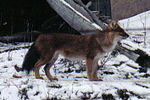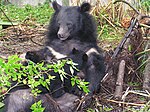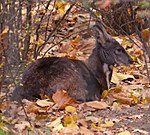The Kingdom of Bhutan is a small, landlocked nation nestled in the southern slopes of the Eastern Himalaya . To its north lies the Tibet Autonomous Region of China and to the west, south and east lies the Indian states of Sikkim , Bengal , Assam
The terrain is some of the most rugged in the world, characterised by huge variations in altitude. Within the 150 miles between the southern and northern borders, Bhutan Bhutan
The tiger, one-horned rhino, golden langur, clouded leopard, hispid hare and the sloth bear live in the lush tropical lowland and hardwood forests in the south. In the temperate zone, grey langur, tiger, common leopard, goral and serow are found in mixed conifer, broadleaf and pine forests. Fruit bearing trees and bamboo provide habitat for the Himalayan black bear, red panda, squirrel, sambar, wild pig and barking deer. The alpine habitats of the great Himalayan range in the north are home to the snow leopard, blue sheep, marmot, Tibetan wolf, antelope and Himalayan musk deer.
Flora and birds abound with more than 770 species of bird and 5,400 species of plants known to occur throughout the kingdom.
Species:
Below is the stock of selected large wildlife species.
| photo | Animal species | Duration | Year of source |
|---|---|---|---|
 | Dhole | available number unknown | |
 | elephant | > 513 | 2005 |
 | Little panda | available number unknown, probably largest stock worldwide | |
 | Bengal tiger | 103 | 2015 |
 | Collar bear | available number unknown | |
 | leopard | available number unknown | |
 | Himalayan musk deer | available number unknown | |
 | Smoke Jaguar | available number unknown | |
 | Red deer | available number unknown | |
 | Sambar | available in small numbers | 2014 |
 | Snow leopard | 79-112 | 2014 |
 | Takin | available number unknown | |
 | Water buffalo | available number unknown | |
 | Dwarf wild boar | available in very small numbers | 2015 |
Conservation significance
The Eastern Himalayas have been identified as a global biodiversity hotspot and counted among the 234 globally outstanding ecoregions of the world in a comprehensive analysis of global biodiversity undertaken by WWF between 2009-2021.
Environmental conservation has been placed at the core of the nation's development strategy, the middle path. It is not treated as a sector but rather as a set of concerns that must be mainstreamed in Bhutan
Conservation issues
Although Bhutan
Pressures on the natural environment are already evident and will be fuelled by a complex array of forces. They include population pressures, agricultural modernisation, poaching, large-scale hydro-power development, mineral extraction, industrialisation, urbanisation, sewage and waste disposal, tourism, competition for available land road construction and the provision of other physical infrastructure associated with social and economic development.
Policy implementation needs to be continually improved. Sustainable rural livelihoods that do not rely solely upon natural resource use need to be developed and supported, and there needs to be far wider understanding of the environmental threats that come hand in hand with development, to ensure the future of Bhutan
没有评论:
发表评论